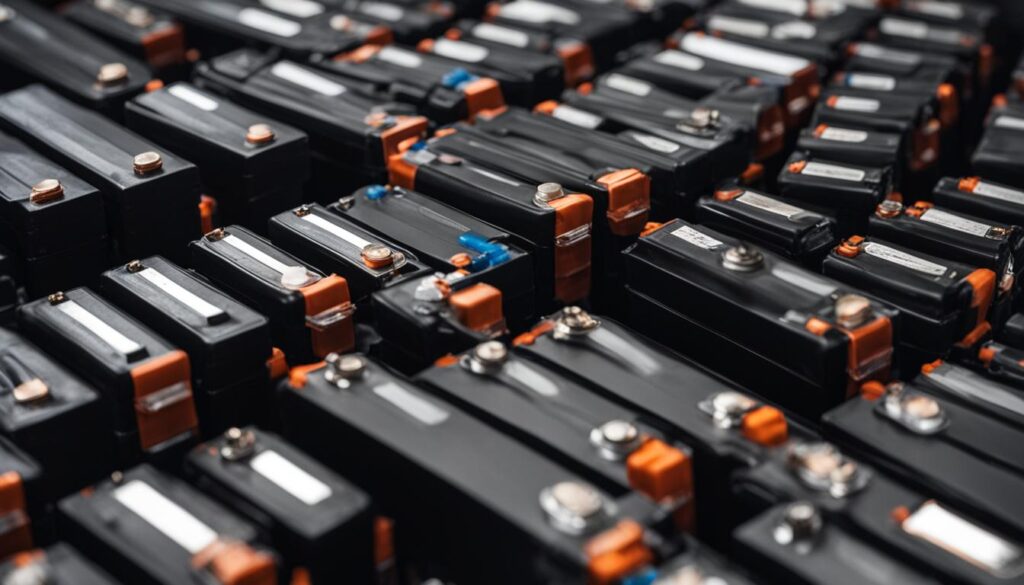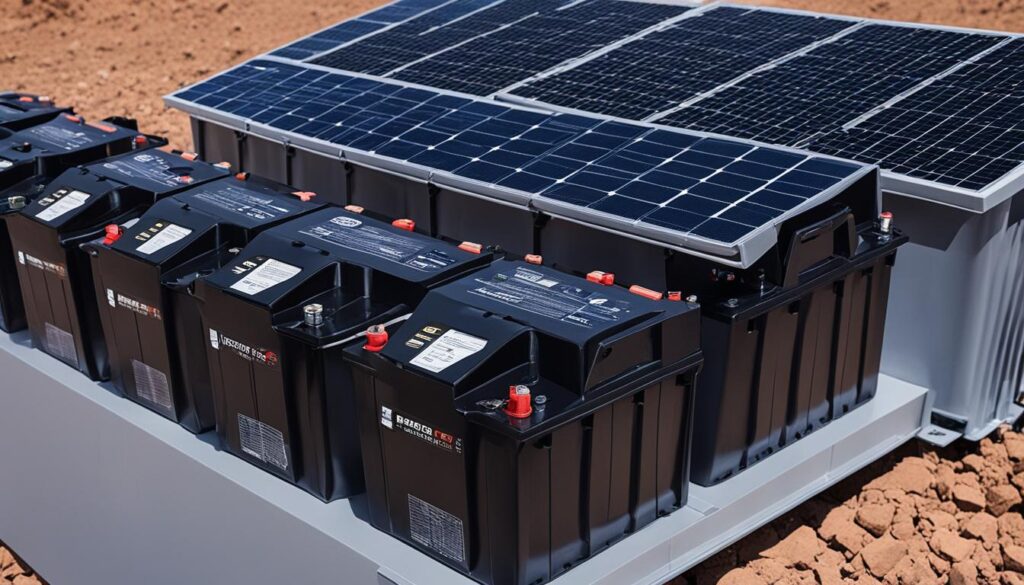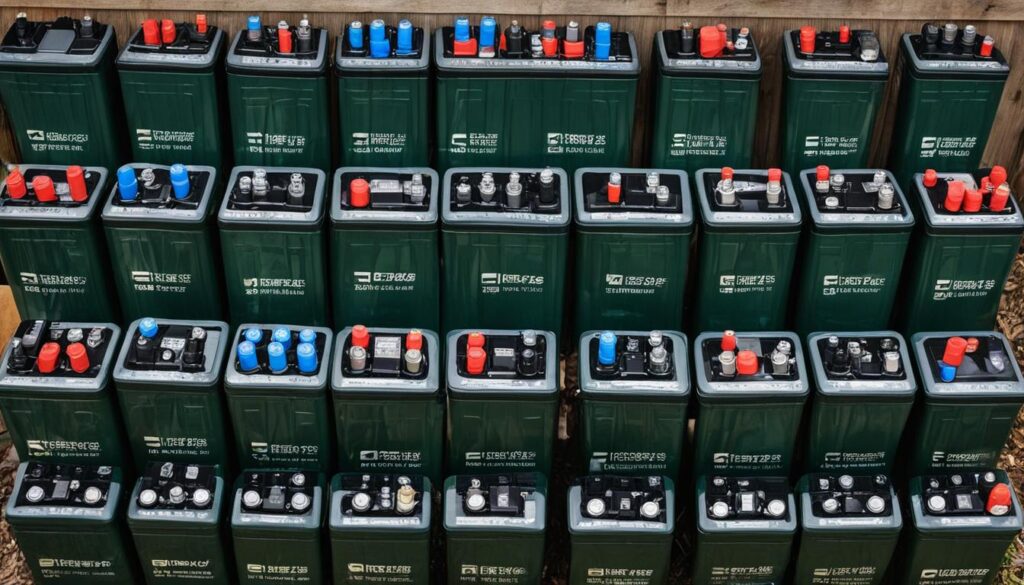
When it comes to off-grid power solutions, deep cycle batteries are the unsung heroes. These long-lasting batteries play a vital role in storing and supplying renewable energy, making them the backbone of off-grid power systems. Whether you’re living off the grid or seeking a reliable backup power source, understanding the benefits and applications of deep cycle batteries, particularly Group 24 batteries, is essential.
Deep cycle batteries, such as the popular Group 24 battery, are designed to provide a steady amount of power over an extended period. Their unique technology allows for deep discharges and recharges, making them perfect for applications where consistent, long-term power is needed.
Group 24 deep cycle batteries have become a go-to choice for a wide range of off-grid applications, such as boats, RVs, solar panels, and off-grid living essentials. Their compatibility, physical dimensions, and various construction types make them versatile and reliable in diverse settings.
In this guide, I will explore the features, benefits, and applications of Group 24 deep cycle batteries, as well as best practices for their storage and maintenance. Let’s uncover the world of deep cycle batteries and discover how they can power your off-grid lifestyle.
Key Takeaways:
- Deep cycle batteries are crucial for off-grid power solutions and renewable energy storage.
- Group 24 batteries are widely used in boats, RVs, solar panels, and off-grid living essentials.
- They are designed to provide long-lasting power with deep discharge and recharge capabilities.
- Group 24 batteries come in various construction types, including flooded lead-acid, gel, AGM, and lithium-ion.
- Proper storage and maintenance practices are essential for maximizing the lifespan and efficiency of deep cycle batteries.
What is a Group 24 Deep Cycle Battery?
A Group 24 deep cycle battery is a specific type of battery classified based on its physical size and terminal placement. According to the Battery Council International (BCI), the Group 24 battery is standardized in its dimensions, making it compatible with various installations. Measuring approximately 10.25 inches in length, 6.8 inches in width, and 8.7 inches in height, this battery size offers a reliable and long-lasting power solution for off-grid applications.
The Battery Council International (BCI) is a renowned industry association that sets standards and guidelines for battery manufacturers and users. By adhering to the Group 24 deep cycle battery specifications provided by the BCI, consumers can confidently select a battery that will fit their specific requirements.
Whether you are powering an RV, boat, or solar energy system, the physical size and terminal placement of a Group 24 battery ensure compatibility with different devices and installations. This standardized sizing enables seamless integration into off-grid power systems, providing a consistent and efficient power supply for extended periods.
Choosing a Group 24 deep cycle battery offers the advantage of flexibility and convenience. The consistent sizing allows for easy replacement and interchangeability, making it a popular choice for both professionals and DIY enthusiasts in various industries.
| Group 24 Deep Cycle Battery | Specification |
|---|---|
| Physical Size | Approximately 10.25 inches (length) x 6.8 inches (width) x 8.7 inches (height) |
| Terminal Placement | Standardized terminal placement according to BCI guidelines |
| Compatibility | Fits various off-grid installations and applications |
As seen in the table above, the Group 24 deep cycle battery’s physical dimensions and terminal placement ensure compatibility and ease of use in different scenarios. Its compact size allows for efficient utilization of limited space, while standardized terminal placement guarantees proper connections in diverse systems.
When seeking reliable, long-lasting power for off-grid applications, the Group 24 deep cycle battery proves to be a dependable choice due to its standardized physical size and terminal placement. This compatibility coupled with its power capabilities makes it a popular option for those seeking sustainable and efficient power solutions.
Features and Pros of Group 24 Deep Cycle Batteries
Group 24 deep cycle batteries offer a range of features and advantages that make them a reliable choice for a variety of applications. Let’s explore some of their key attributes:
Group 24 deep cycle batteries have physical dimensions that allow them to fit seamlessly into standardized battery spaces in various vehicles and systems. This compatibility ensures easy installation and replacement, making Group 24 batteries a popular choice for both marine and RV applications.
One of the defining features of Group 24 batteries is their capacity, which typically falls within the range of 70-85 amp-hours (Ah). This capacity determines the amount of energy the battery can store and supply, providing long-lasting power for extended off-grid use.
With a standard voltage of 12 volts, Group 24 batteries are well-suited for marine, RV, and solar energy systems. Their 12-volt rating ensures compatibility with a wide range of equipment and devices, offering a reliable power source for your off-grid needs.
Group 24 deep cycle batteries are designed to handle deep discharges and frequent recharging, allowing for reliable performance over an extended battery life cycle. Whether you’re exploring the open waters or embracing an off-grid lifestyle, Group 24 batteries provide the power you need, when you need it.
These batteries are available in different construction types, including flooded lead-acid, gel, AGM, and in some cases, lithium-ion. Each construction type offers unique benefits and considerations, allowing you to choose the battery that best suits your specific requirements.
When it comes to maintenance, Group 24 batteries offer varying levels of care. Flooded lead-acid batteries require regular checks and occasional topping up of water, while AGM and gel batteries provide virtually maintenance-free operation. This flexibility ensures you can choose the battery that aligns with your desired maintenance levels.
With their versatile features, robust construction, and reliable performance, Group 24 deep cycle batteries are an excellent choice for powering your off-grid endeavors.
| Features | Pros |
|---|---|
| Physical dimensions | Fits standardized battery spaces in various vehicles and systems |
| Capacity | Typically ranges from 70-85 Ah for long-lasting power |
| Voltage | Standard 12-volt rating suits marine, RV, and solar systems |
| Deep discharge | Designed for deep discharges and frequent recharging |
| Construction types | Flooded lead-acid, gel, AGM, and in some cases, lithium-ion options |
| Maintenance levels | Varying maintenance requirements to suit different preferences |

Image related to Group 24 deep cycle batteries
Applications of Group 24 Batteries
Group 24 deep cycle batteries have a wide range of applications. They are commonly used as house batteries in RVs to power lights and appliances when not connected to shore power. In boats, Group 24 batteries are used to power trolling motors, electronics, and lights. They are also used in solar power systems to store energy collected from solar panels. Group 24 batteries can power mobility scooters and electric wheelchairs, ensuring extended travel distances between charges.
For off-grid cabins and homes, Group 24 batteries store energy from renewable sources like wind or solar, enabling electrical power where the grid does not reach. They are also used in backup power systems, portable power stations, and various commercial equipment. Group 24 batteries can be essential components in uninterruptible power supplies, ensuring critical systems remain operational during power outages.

Whether you’re exploring renewable energy projects or need reliable backup power, Group 24 deep cycle batteries offer versatile applications across various industries. Their robust performance and durability make them the ideal choice for powering RVs, boats, solar systems, mobility aids, and much more.
Choosing the Right Group 24 Deep Cycle Battery
When it comes to selecting a Group 24 deep cycle battery, several factors need to be considered to ensure you choose the right battery for your needs. These factors include capacity, voltage, reserve capacity, and the specific application in which the battery will be used.
The capacity of a Group 24 battery is measured in amp-hours (Ah) and indicates the amount of energy it can store and supply. A higher capacity allows for longer periods of continuous power. Consider the power demands of your application to determine the appropriate capacity.
The voltage of a Group 24 battery is typically 12 volts, which is suitable for most applications. However, it’s essential to confirm that the battery’s voltage matches the requirements of your specific system.
The reserve capacity of a battery indicates how long it can run a specified load before needing to be recharged. This is particularly important in applications where backup power is crucial, such as emergency situations or off-grid power systems.
Group 24 deep cycle batteries come in various types, each with its advantages and disadvantages. The most common types include flooded lead-acid, gel, AGM, and lithium-ion batteries. Consider the characteristics and maintenance requirements of each type to determine which one best suits your needs and preferences.
By carefully considering capacity, voltage, reserve capacity, and type, you can select the right Group 24 deep cycle battery that meets your power requirements and ensures reliable performance in your specific application.
Types of Group 24 Deep Cycle Batteries
When it comes to Group 24 deep cycle batteries, there are several different types available, each with its own unique characteristics and advantages. Understanding these different types can help you choose the right battery for your specific needs and requirements.
Flooded Lead-Acid Batteries
Flooded lead-acid batteries are the traditional choice for deep cycle applications. They offer a cost-effective option and have well-understood characteristics. These batteries require regular maintenance, including checking and topping up the water levels, but they are known for their durability and consistent performance.
AGM Batteries
AGM (Absorbent Glass Mat) batteries have become increasingly popular due to their maintenance-free design and spill-proof construction. A separator made of glass fibers holds the electrolyte, resulting in a battery that is versatile, reliable, and easy to handle. AGM batteries are an excellent choice for applications where maintenance is a concern.
Gel Batteries
Gel batteries are known for their durability and resistance to deep discharge. They use a gel electrolyte that immobilizes the sulfuric acid, making them leak-proof and vibration resistant. Gel batteries are an excellent choice for challenging environments and applications that require long-lasting battery performance.
Lithium-Ion Batteries
While not a traditional lead-acid battery, lithium-ion batteries have gained popularity in recent years due to their lightweight design and high energy density. They offer a longer lifespan, faster charging times, and increased energy efficiency compared to other battery types. Lithium-ion batteries are an excellent choice for applications where weight and size are crucial factors.
Each type of Group 24 deep cycle battery has its own advantages and considerations. It’s essential to evaluate your specific needs, budget, and application requirements before making a decision. Whether you choose flooded lead-acid, AGM, gel, or lithium-ion, you can find a Group 24 battery that will provide reliable and consistent power for your off-grid or backup power needs.
| Battery Type | Advantages | Considerations |
|---|---|---|
| Flooded Lead-Acid | Cost-effective, durable, consistent performance | Requires regular maintenance, can leak if not properly maintained |
| AGM | Maintenance-free, spill-proof, versatile | Higher upfront cost, lower capacity compared to flooded batteries |
| Gel | Durable, resistant to deep discharge, leak-proof | Higher upfront cost, lower capacity compared to flooded batteries |
| Lithium-Ion | Lightweight, high energy density, longer lifespan | Higher upfront cost, requires specialized charging equipment |

Best Practices for Battery Storage and Maintenance
Proper battery storage and maintenance are crucial for ensuring the longevity and performance of your Group 24 deep cycle battery. By following these best practices, you can maximize the lifespan and efficiency of your battery:
- Store batteries in a cool, dry place: It is important to keep your batteries in a location that is not exposed to extreme temperatures or moisture. This helps prevent damage to the battery cells and extends their lifespan.
- Follow manufacturer’s charging guidelines: Different batteries have specific charging requirements, including the optimal charging voltage and current. Adhering to the manufacturer’s guidelines ensures safe and efficient charging, minimizing the risk of overcharging or undercharging.
- Regularly inspect batteries: Conduct routine inspections to check for any signs of damage, leaks, or wear. Look for bulging or swelling of the battery casing, corroded terminals, or any unusual odors. If you notice any issues, consult the manufacturer or a qualified technician for further guidance.
- Perform proper battery maintenance: Depending on the battery type, maintenance requirements may vary. For flooded lead-acid batteries, regularly check the water levels and top up with distilled water as needed. AGM and gel batteries require little to no maintenance. Follow the manufacturer’s instructions for your specific battery type to ensure proper care.
- Take safety precautions: When handling batteries, always wear protective gloves and goggles to prevent any contact with corrosive chemicals or electrolytes. Avoid short-circuiting the battery terminals and keep them away from sources of heat or flame.
- Dispose of old or damaged batteries responsibly: When your Group 24 deep cycle battery reaches the end of its lifespan or becomes damaged beyond repair, it is essential to dispose of it properly. Check with your local recycling center or battery retailers for battery disposal options in your area.
Following these best practices will help ensure the optimal performance, safety, and environmental responsibility of your Group 24 deep cycle battery throughout its lifespan.
Conclusion
Deep cycle batteries, specifically Group 24 deep cycle batteries, play a vital role in providing reliable power for off-grid solutions. With their deep discharge capabilities and compatibility with various applications, these batteries are an ideal choice for RVs, boats, and solar power systems. By selecting the right battery, understanding the different types available, and adhering to best practices for storage and maintenance, users can ensure optimal performance and longevity from their Group 24 deep cycle batteries.
Proper battery care is essential to fully enjoy the benefits of off-grid power solutions while minimizing risks and maximizing efficiency. Remember to store batteries in a cool, dry place away from extreme temperatures to maintain their longevity. Follow the manufacturer’s charging guidelines and regularly inspect batteries for any damage or wear. Adhering to safety precautions when handling batteries is equally important.
When it comes to battery disposal, it is vital to dispose of old or damaged batteries responsibly, ensuring they are recycled or disposed of in accordance with local regulations. By following these best practices for battery storage and maintenance, individuals can make the most of their deep cycle batteries, maximize their lifespan, and contribute to a sustainable power solution for their off-grid needs.
FAQ
What is a Group 24 deep cycle battery?
A Group 24 deep cycle battery refers to a specific physical size and terminal placement according to the Battery Council International (BCI). It is a standardized size typically measuring around 10.25 inches in length, 6.8 inches in width, and 8.7 inches in height. This standardized sizing ensures compatibility in various installations.
What are the features and advantages of Group 24 deep cycle batteries?
Group 24 deep cycle batteries have physical dimensions that allow them to fit in standardized battery spaces. They typically have a capacity range of 70-85 amp-hours (Ah) and a standard voltage of 12 volts. These batteries are designed for deep discharge and recharging, making them suitable for marine, RV, and solar energy systems. They can come in different construction types, with maintenance levels varying depending on the type.
What are the applications of Group 24 batteries?
Group 24 batteries are commonly used as house batteries in RVs, powering lights and appliances when not connected to shore power. They are also used in boats to power trolling motors, electronics, and lights. Group 24 batteries are used in solar power systems, mobility scooters, and electric wheelchairs. For off-grid cabins and homes, they store energy from renewable sources like wind or solar. Group 24 batteries are also used in backup power systems, portable power stations, commercial equipment, and uninterruptible power supplies, ensuring critical systems remain operational during outages.
How do I choose the right Group 24 deep cycle battery?
When selecting a Group 24 deep cycle battery, consider factors such as capacity, voltage, reserve capacity, and the specific application. The battery’s capacity, measured in amp-hours (Ah), indicates how much energy it can store and supply. The voltage of a Group 24 battery is typically 12 volts, which suits most applications. The reserve capacity tells you how many minutes the battery can run a specified load before needing recharging. Different types of Group 24 deep cycle batteries, such as flooded lead-acid, gel, AGM, and lithium-ion, have various advantages and considerations based on your needs and preferences.
What are the types of Group 24 deep cycle batteries available?
There are several types of Group 24 deep cycle batteries available. Flooded lead-acid batteries are the traditional choice, offering a cost-effective option with well-understood characteristics. AGM batteries are maintenance-free and spill-proof, making them versatile and reliable. Gel batteries are known for their durability and resistance to deep discharge. Lithium-ion batteries have gained popularity due to their lightweight and high energy density. Each type has its own advantages and considerations, so choose the right type based on your specific needs and requirements.
What are the best practices for storage and maintenance of Group 24 deep cycle batteries?
Proper storage and maintenance are crucial for ensuring the longevity and performance of Group 24 deep cycle batteries. Best practices include storing batteries in a cool, dry place away from extreme temperatures, following the manufacturer’s charging guidelines, regularly inspecting batteries for damage or wear, performing proper battery maintenance, taking safety precautions when handling batteries, and disposing of old or damaged batteries responsibly.
What are the benefits of deep cycle batteries for off-grid power solutions?
Deep cycle batteries, like Group 24 deep cycle batteries, provide a steady amount of power over a long period. They are designed for applications where consistent, long-term power is needed. Deep cycle batteries are essential for robust off-grid power solutions, storing renewable energy and providing power when the grid is not accessible. They are widely used in various off-grid applications, including boats, RVs, solar panels, and off-grid living essentials.
How can deep cycle batteries contribute to sustainable power solutions?
Deep cycle batteries, such as Group 24 batteries, play a vital role in sustainable power solutions. By storing renewable energy from sources like solar and wind, they enable the use of clean energy even when the sun is not shining or the wind is not blowing. This reduces dependence on non-renewable energy sources and helps reduce carbon emissions. Deep cycle batteries also allow for reliable off-grid power solutions in remote areas, enabling sustainable living and reducing reliance on fossil fuels.


